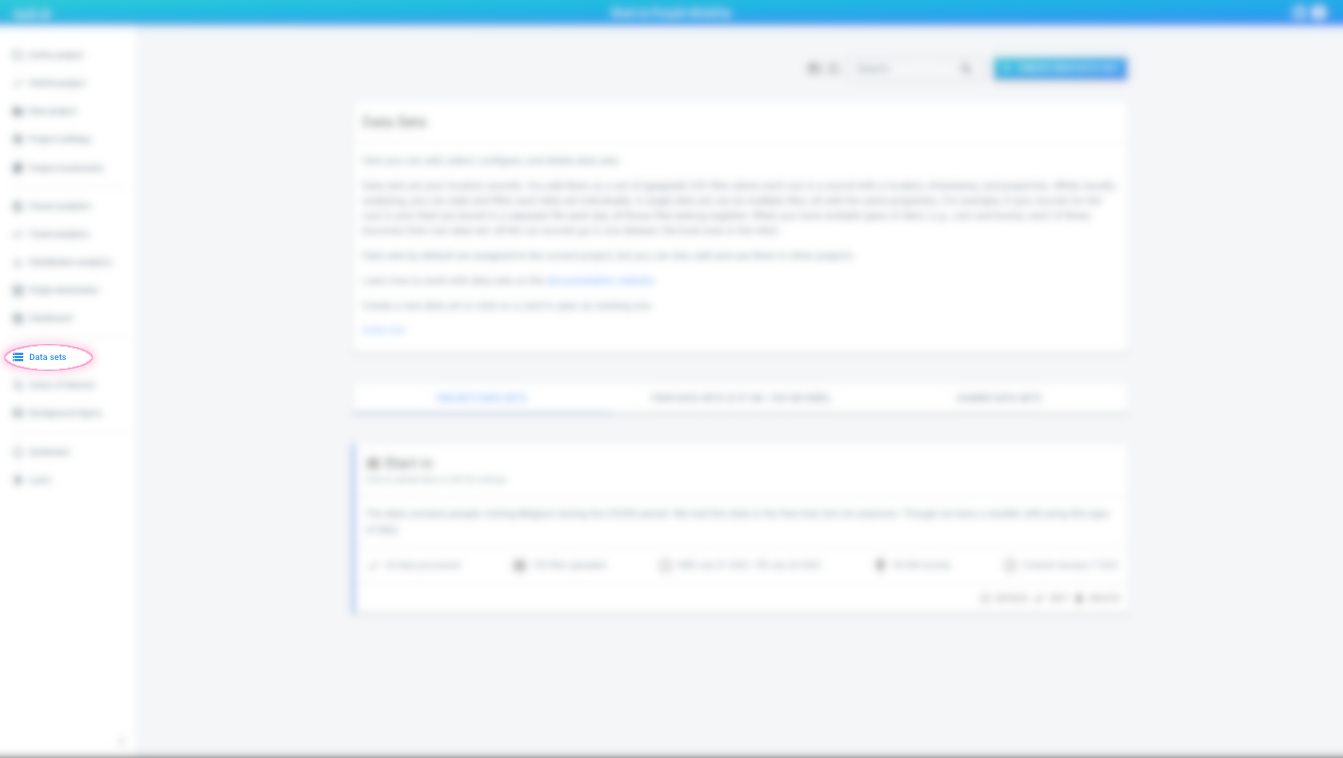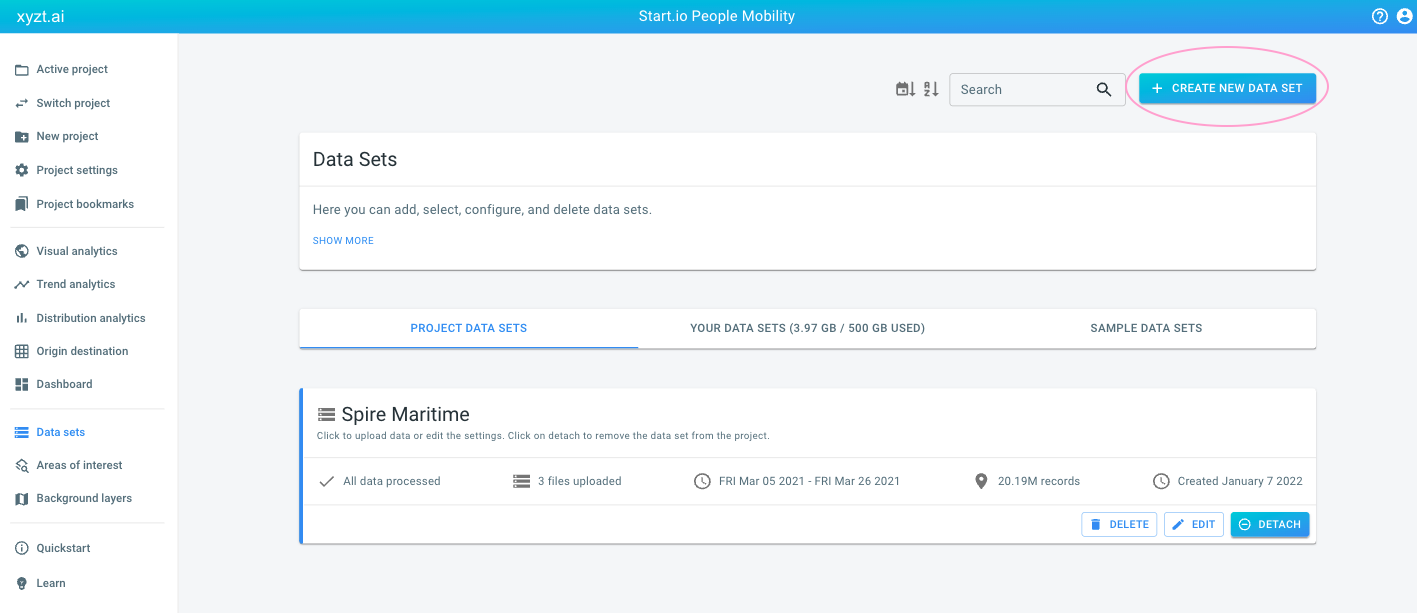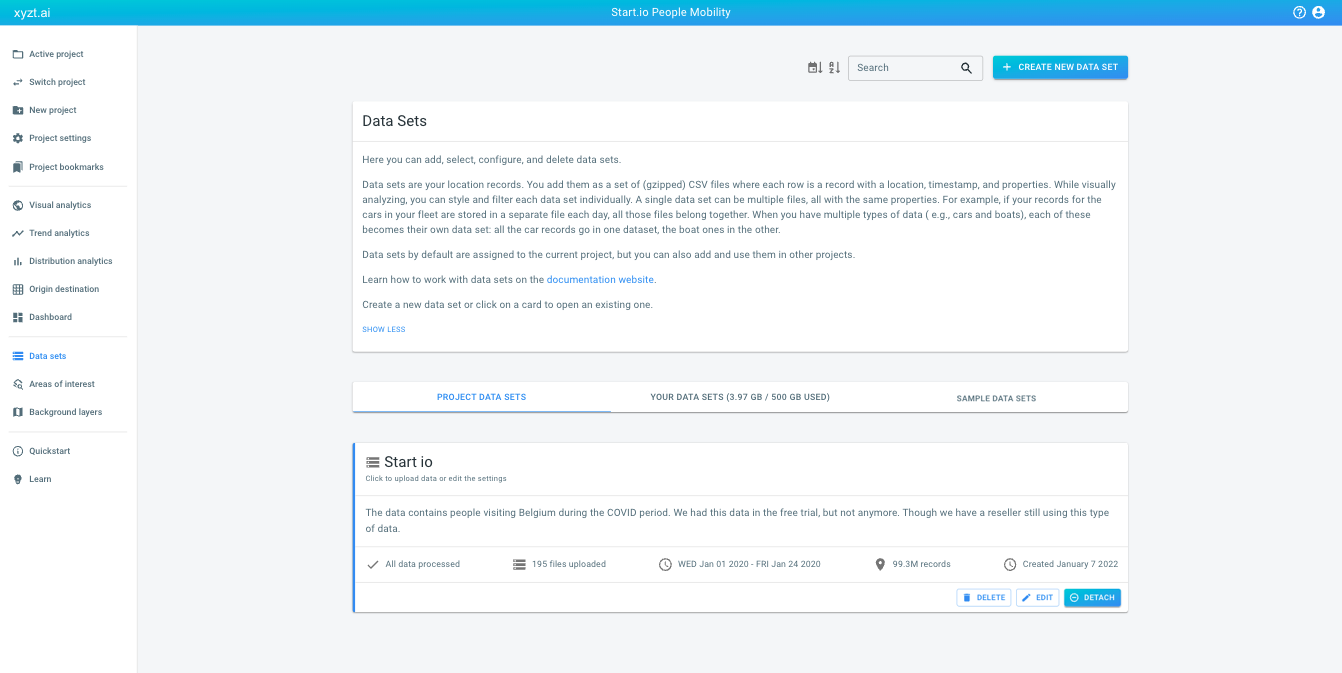
What are data sets?
A data set is the resource that will contain your spatio-temporal data that you want to use for visualization and analysis. You create a new data set for each collection of files with records.
For example, one data set can contain files with GPS records of cars. Another data set could contain people’s location during an indoor event.
How to create a new data set
Step 1: Navigate to the 'New data set' page
by first clicking on the Data sets button in the left navigation bar
and then on the Create new data set button in the top right corner of the Data sets page.
Step 2: Create the data set
by specifying the Name, the Data type, the Asset or entity type and the Description.
-
The Name is used in the UI when we need to refer to that layer. This is a good location to add some more details about this data set.
-
The Data type of the data set indicates what kind of data set you want to create. This depends on the data you want to upload. The different types of data sets article explains the differences between the different types. You can choose between:
-
Geometry Data (GeoJSON or SHP files without time information)
-
Time Series Data (temporal data in CSV/Parquet files for fixed shapes defined as points, lines, or polygons in GeoJSON or SHP files)
-
Point Data (Locations, time stamps, and attributes in CSV/Parquet files for unrelated measurements/events)
-
Movement Data (Traces/trips of locations, time stamps, and attributes in CSV/Parquet files for vehicles or people that move)
-
Movement Path Data (Series of trips along a traffic network with network locations, time stamps, and attributes in CSV or Parquet files)
-
-
For some data set types you have to select the data file and metadata file type (CSV or Parquet). The data upload wizard will adapt to your selection here.
-
You have to describe either What is moving or What your shapes represent. Examples are road segments, city neighborhoods,… This name will appear on the different analytics pages.
-
The optional description is shown on the overview page with all the data sets.
Once you have filled in the form, press the Create data set button.
Step 2 alternative: copy from a template
When you have data that you want to split over multiple data sets (for example one data set containing the data of January, another the data of February, …), you can create a new data set by copying the settings and properties of an existing data set.
The new data set will have all the same settings and properties as the existing data set, but will not yet contain any data.
This allows you to immediately start uploading data to your data set, without having to define the properties first.
You can do this by activating the INITIALIZE_FROM_EXISTING tab at the top of the Create data set page.
The page allows you to create a new data set, with all settings initialized from an existing data set. The name and description of the new data set need to be configured as well.
Step 3: Upload your CSV, Parquet, GeoJSON, and SHP files to the data set
At this point, the data set is created, but it doesn’t contain any location data yet.
You need to upload your .csv, .parquet, .geojson, and .zip files to the data set before you can do anything useful with it.
-
Data sets containing movement data: see the data upload article for movement data for more information on how to do this, or follow a tutorial where you will upload some sample movement data to a data set.
-
Data sets containing movement path data: see the data upload article for movement path data for more information on how to do this, or follow a tutorial where you will upload some sample movement path data to a data set.
-
Data sets containing time series data: see the data upload article for time series data for more information on how to do this, or follow a tutorial where you will upload some sample time-series data to a data set.
How to delete a data set
|
Following these steps will delete the data set from the platform
This article describes how to delete a data set from the platform. Consult the Manage data in a project article if you only want to remove a data set from a project. |
Step 1: Navigate to the 'Data sets overview' page
by clicking on the Data sets button in the left navigation bar
Step 2: Find the data set you want to delete
The data sets overview page lists all the data sets to which you have access.
There are 3 tabs to select data sets from:
-
PROJECT DATA SETS: shows the data sets that are currently included in the active project, if any
-
YOUR DATA SETS: lists all the data sets in your account created by any member of your team. This includes both the data sets included in the current active project, and ones which aren’t included.
-
SAMPLE DATA SETS: these are example data sets that you can use in your own projects.
Find the card of the data set you want to delete.
|
Use the search box at the top of the page
To make it easier to find the data set you are looking for, you can:
|








